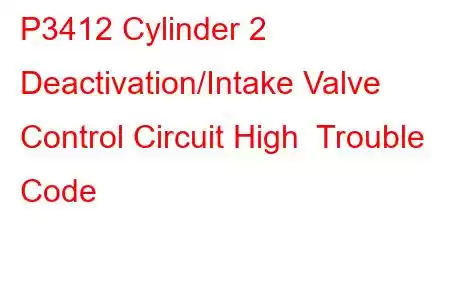P3412 Cylinder 2 Deactivation/Intake Valve Control Circuit High
OBD-II Trouble Code Technical Description
Cylinder 2 Deactivation/Intake Valve Control Circuit High
What does that mean?
This is a generic powertrain diagnostic trouble code (DTC) and applies to many OBD-II vehicles (1996-newer). That may include but is not limited to vehicles from General Motors, Dodge, Jeep, Chevrolet, Chrysler, Ram, etc. Although generic, the exact repair steps may vary depending on year, make, model and powertrain configuration.
OBD-II trouble code P3412 and related codes P3409, P3410 and P3411 are associated with the cylinder #2 deactivation/intake valve control circuit.
The purpose of the cylinder 2 deactivation/intake valve control circuit is to accommodate the cylinder deactivation feature (e.g. V4 mode of a V8 engine) to improve fuel economy during light load operation such as highway driving. The Engine Control Module (ECM) controls the 4 or 8 cylinder modes of the engine by engaging the intake deactivating solenoids for four of the engine cylinders. This code pertains to the number 2 cylinder and the other three cylinders in this process are determined by the engine configuration and the firing order of the cylinders. The number one cylinder deactivation solenoid is mounted on or near the intake in the vicinity of that cylinder based of the specific vehicle and the configuration.
When the ECM detects voltage or resistance that is too high above the normal expected value range within the cylinder 2 deactivation/intake valve control circuit, code P3412 will be set and the check engine light, service engine soon light or both may be illuminated. In some circumstances, the ECM may disable the injector to the #2 cylinder until the issue is corrected and the code has been cleared causing a noticeable engine misfire.
Cylinder deactivation solenoids:
What is the severity of this DTC?
The severity of this code can vary tremendously from moderate to severe depending on the specific symptoms of the malfunction. A misfire requires immediate attention because it can cause permanent damage to internal engine components.
What are some of the symptoms of the code?
Symptoms of a P3412 trouble code may include:
Engine may misfire Increased fuel consumption Poor engine performance Service engine soon light illuminated Check engine light illuminatedWhat are some of the common causes of the code?
Causes for this P3412 code may include:
Defective cylinder deactivation solenoid Low engine oil level or pressure Restricted oil passage Faulty or damaged wiring Corroded, damaged or loose connector Defective ECMWhat are some P3412 troubleshooting steps?
The first step in the troubleshooting process for any malfunction is to research the Technical Service Bulletins (TSB's) for the specific vehicle by year, model and engine. In some circumstances, this can save a lot of time in the long run by pointing you in the right direction.
The second step is to check the condition of the engine oil and confirm it is serviced to the appropriate level. Then locate all components associated with the cylinder 2 deactivation intake valve control circuit and look for obvious physical damage. Based on the specific vehicle, this circuit may incorporate several components including the deactivation solenoid, switches, fault indicators and the ECM. Perform a thorough visual inspection to check the associated wiring for obvious defects such as scraping, rubbing, bare wires, or burn spots. Next is to check the connectors and connections for security, corrosion and damaged pins. This process must include all wiring connectors and connections to all components including the ECM. Consult the specific tech data for the vehicle to verify the configuration of the cylinder 2 deactivation/intake valve control circuit and confirm every
Read: 22


